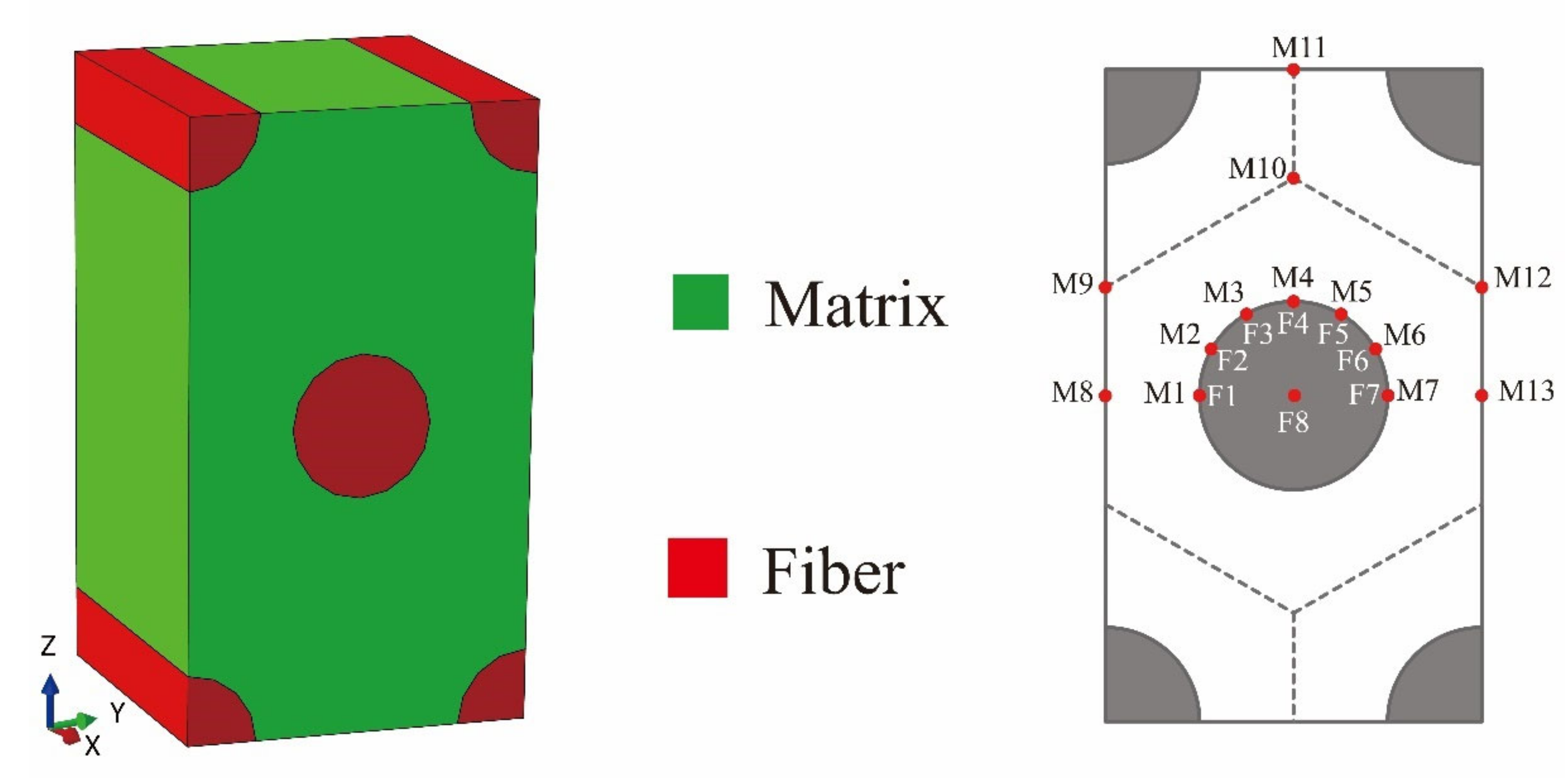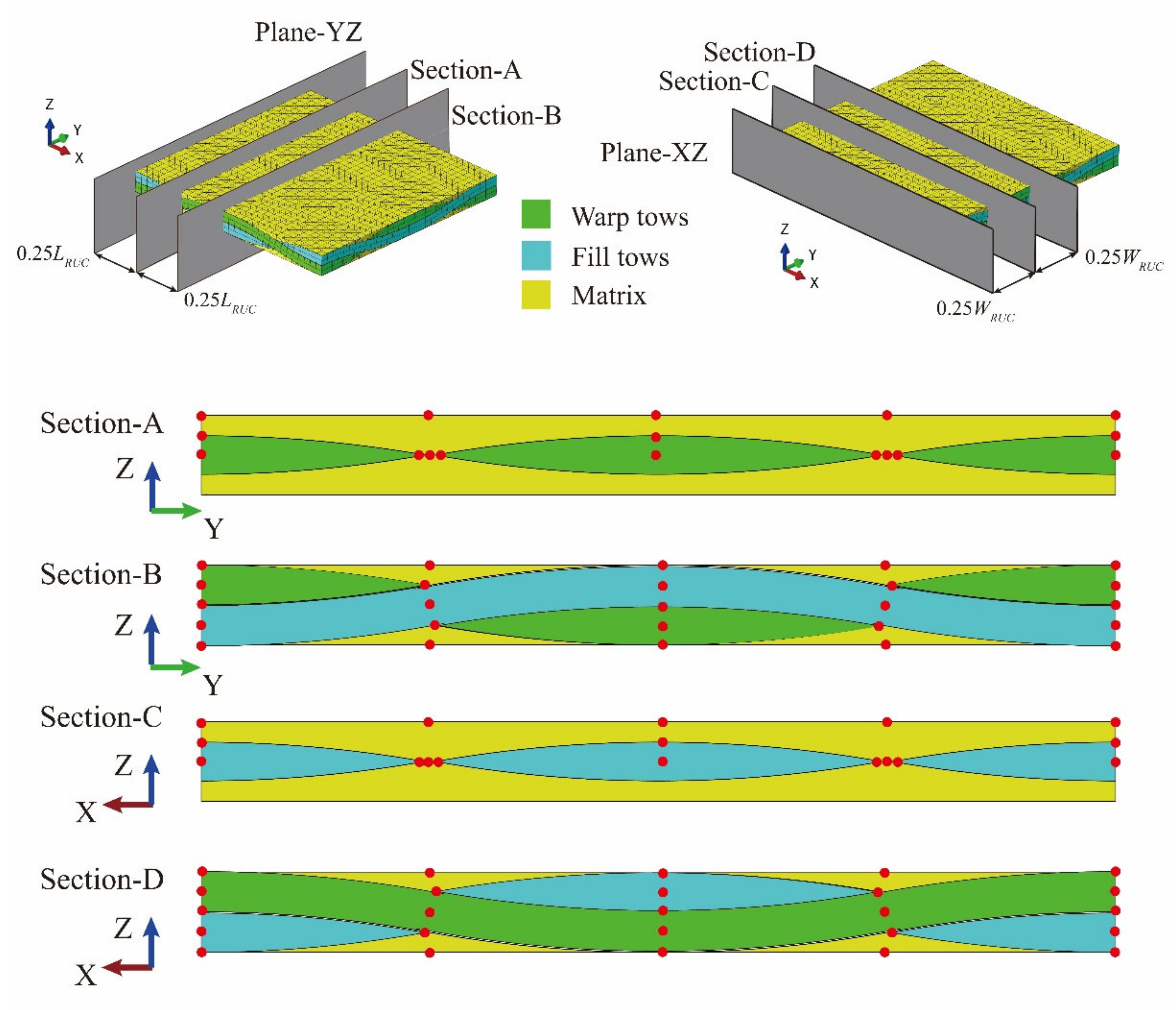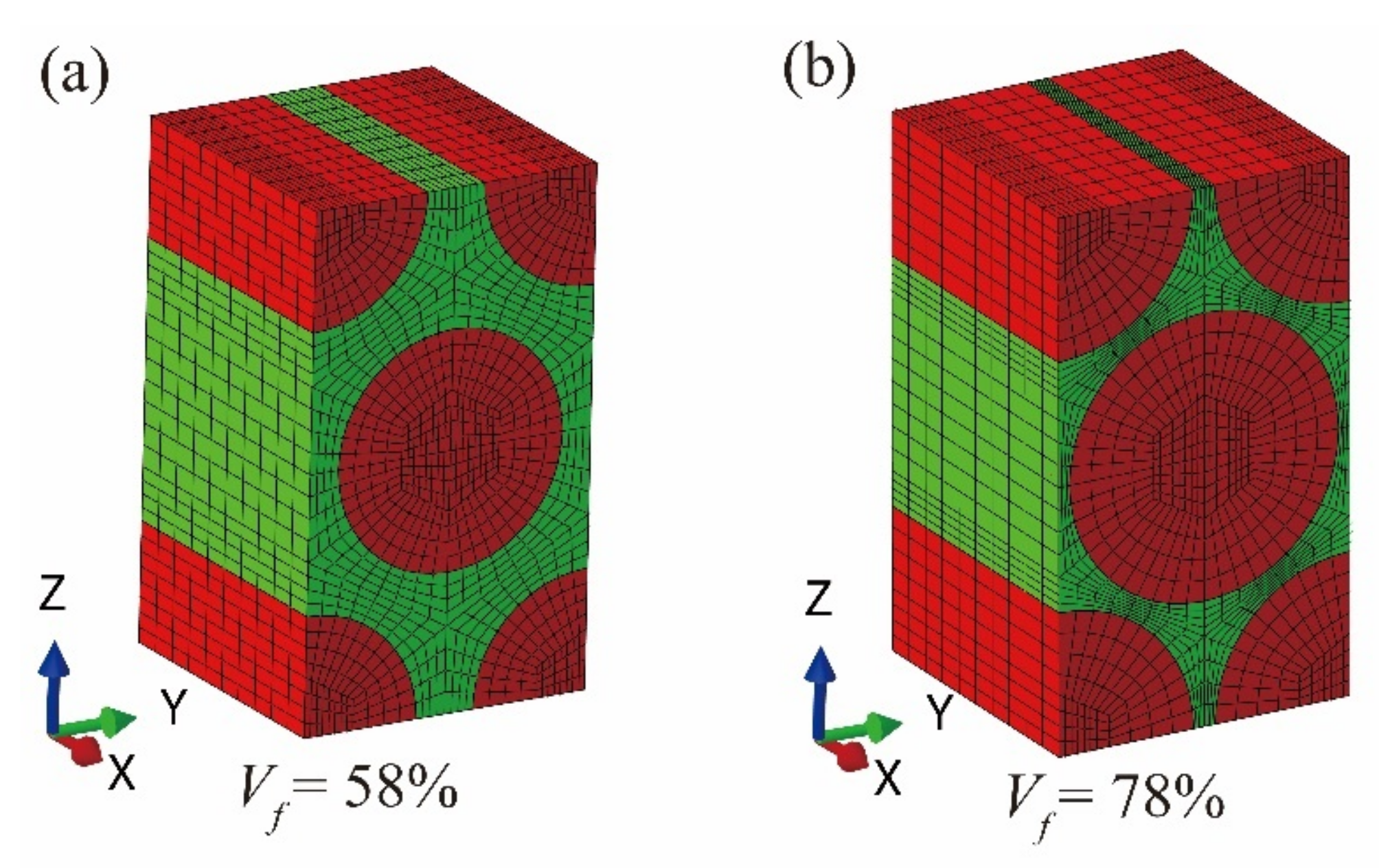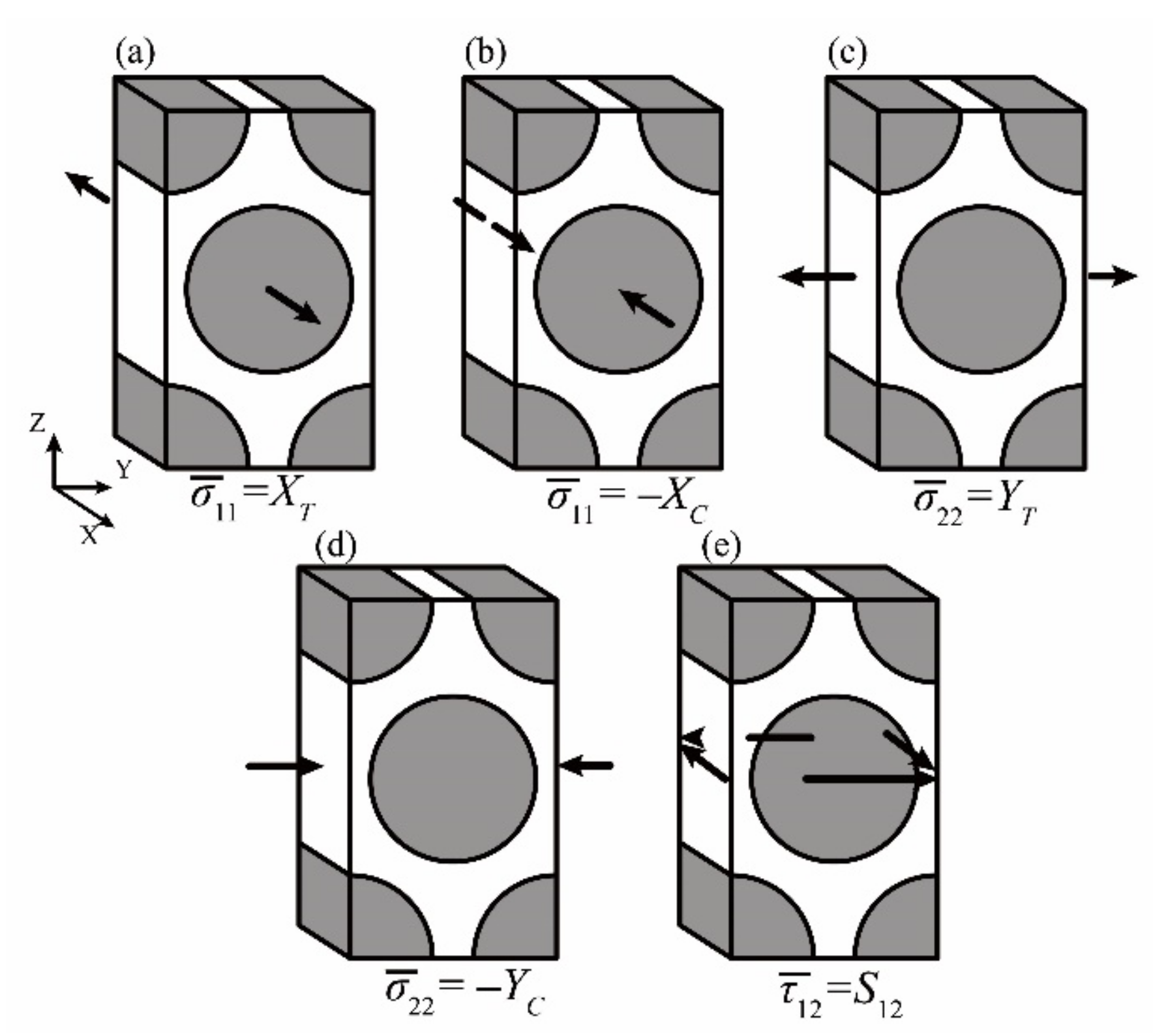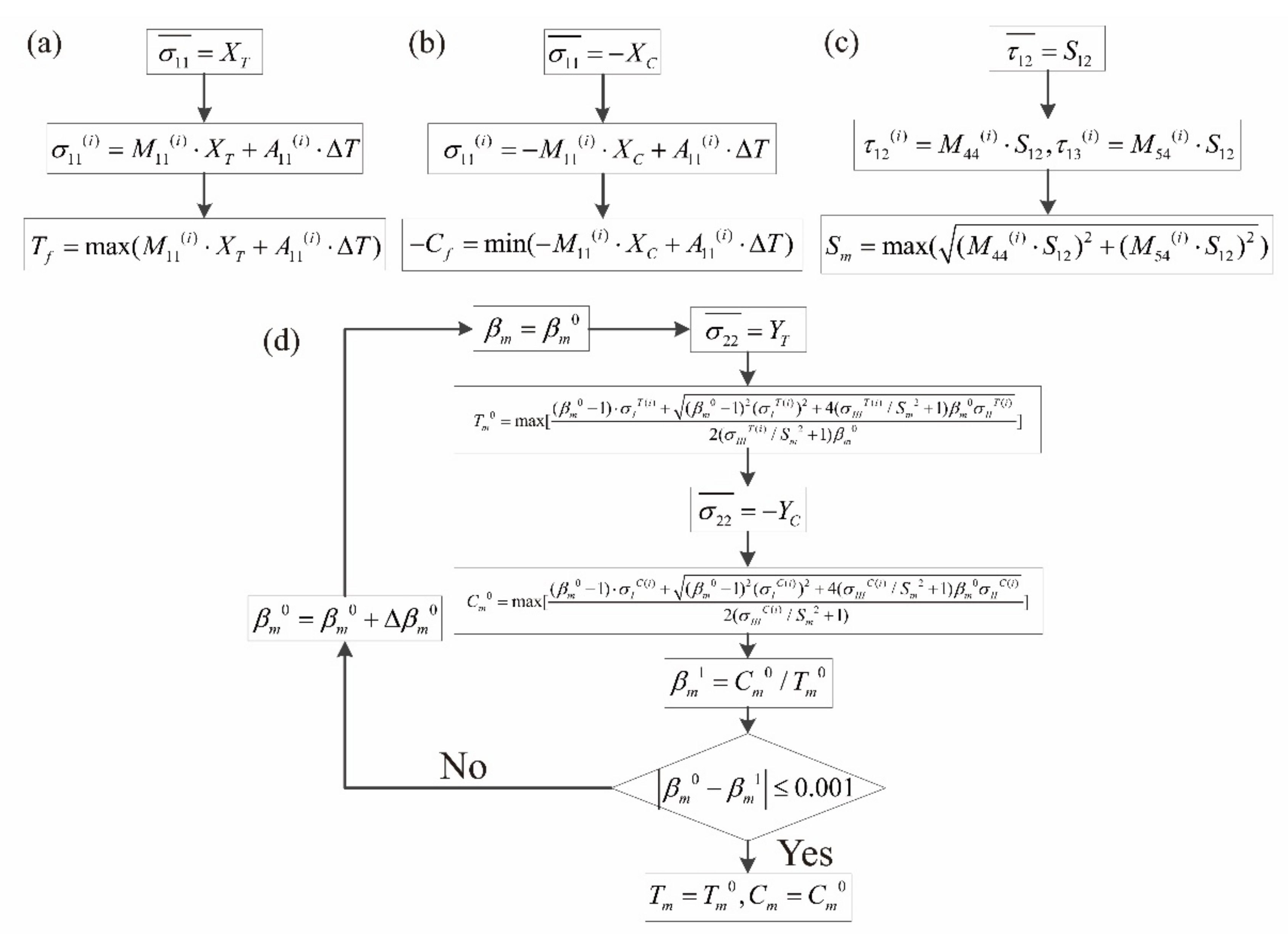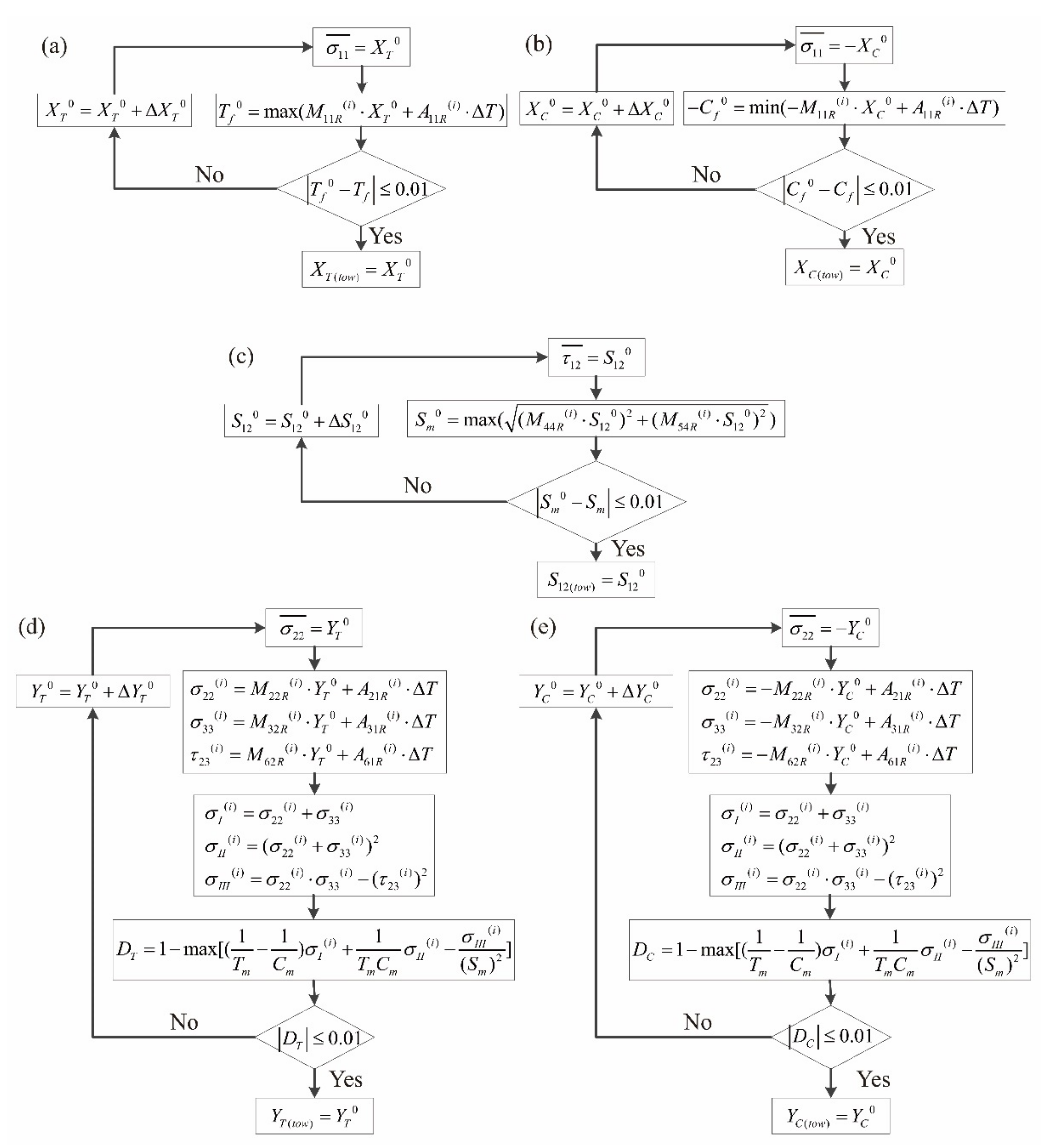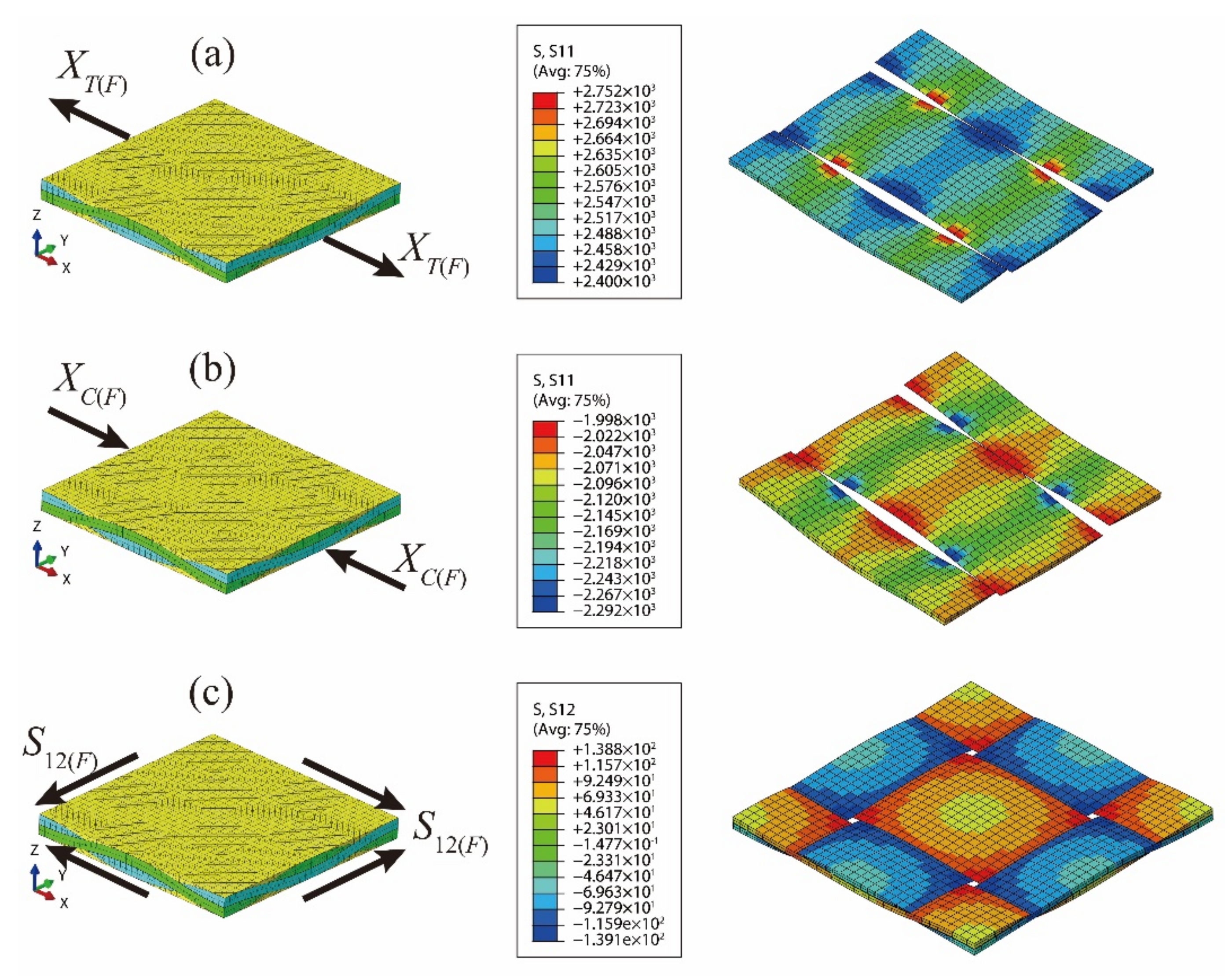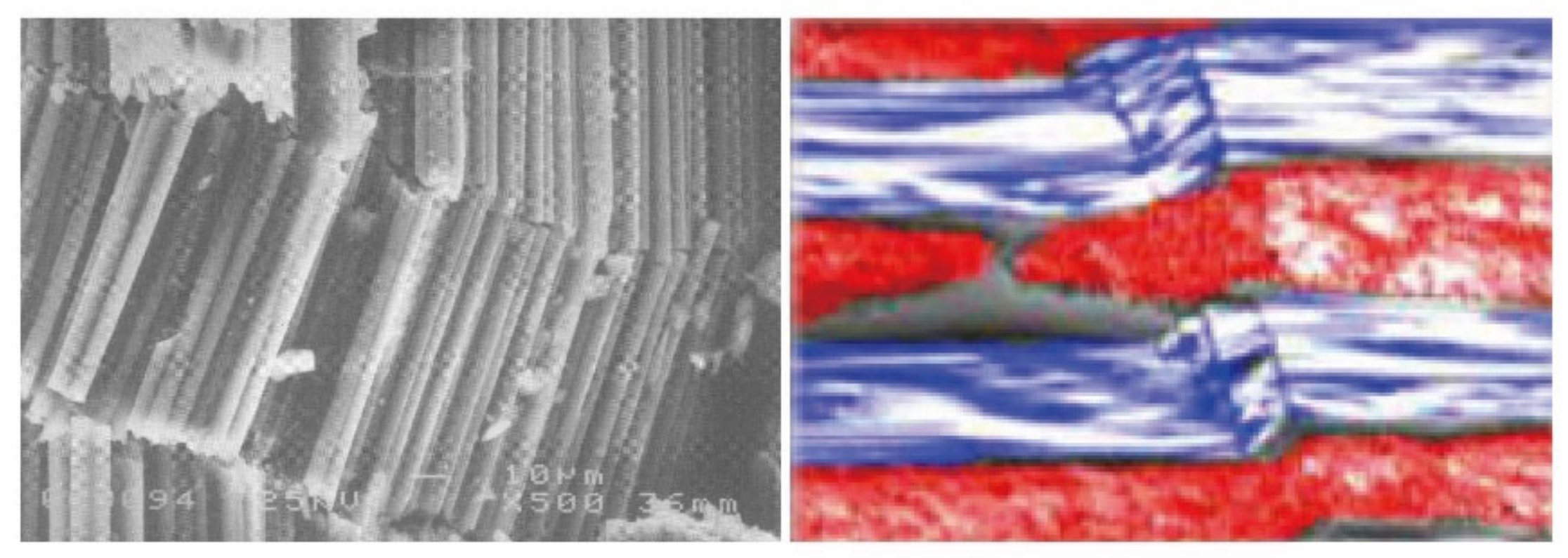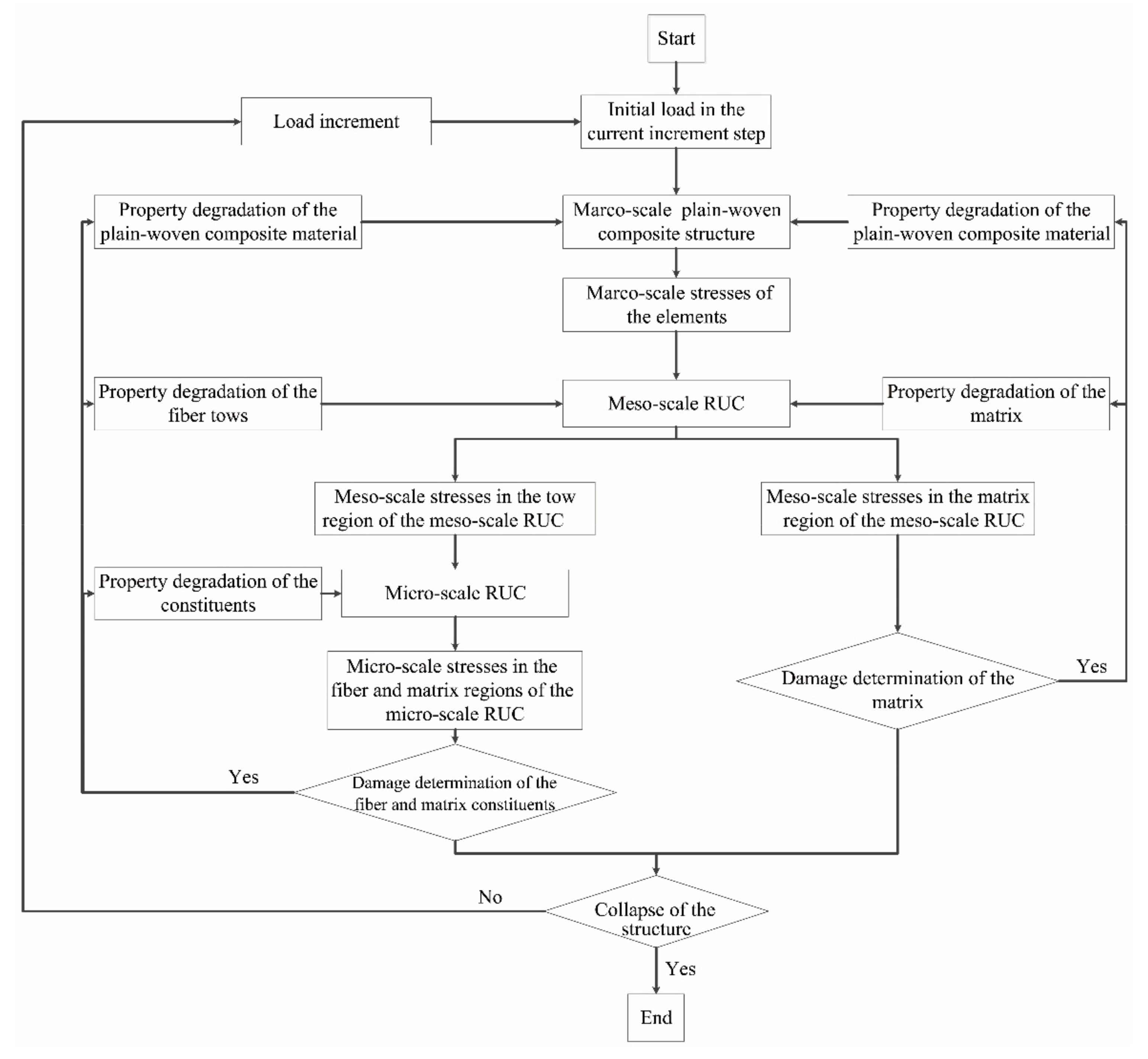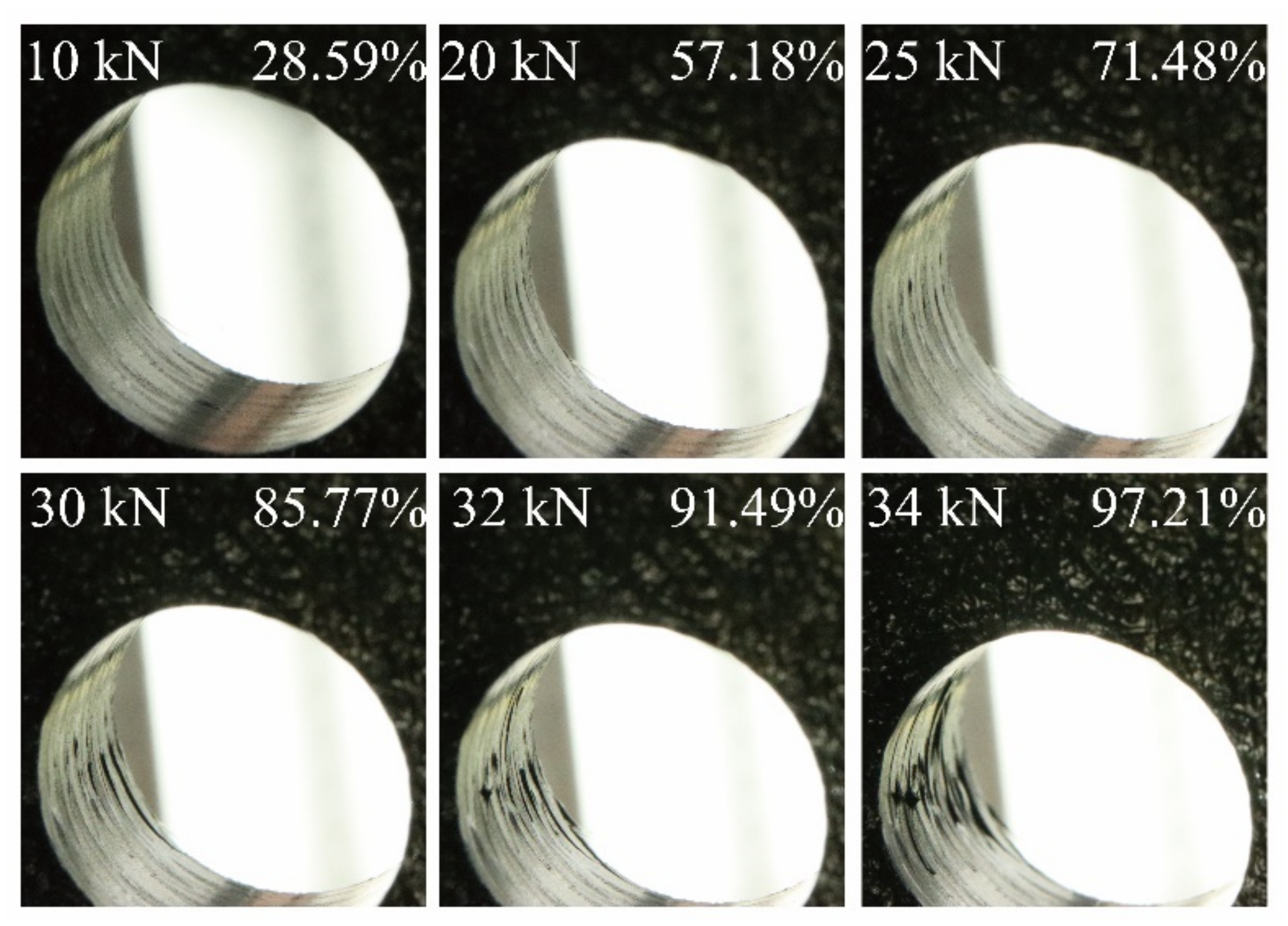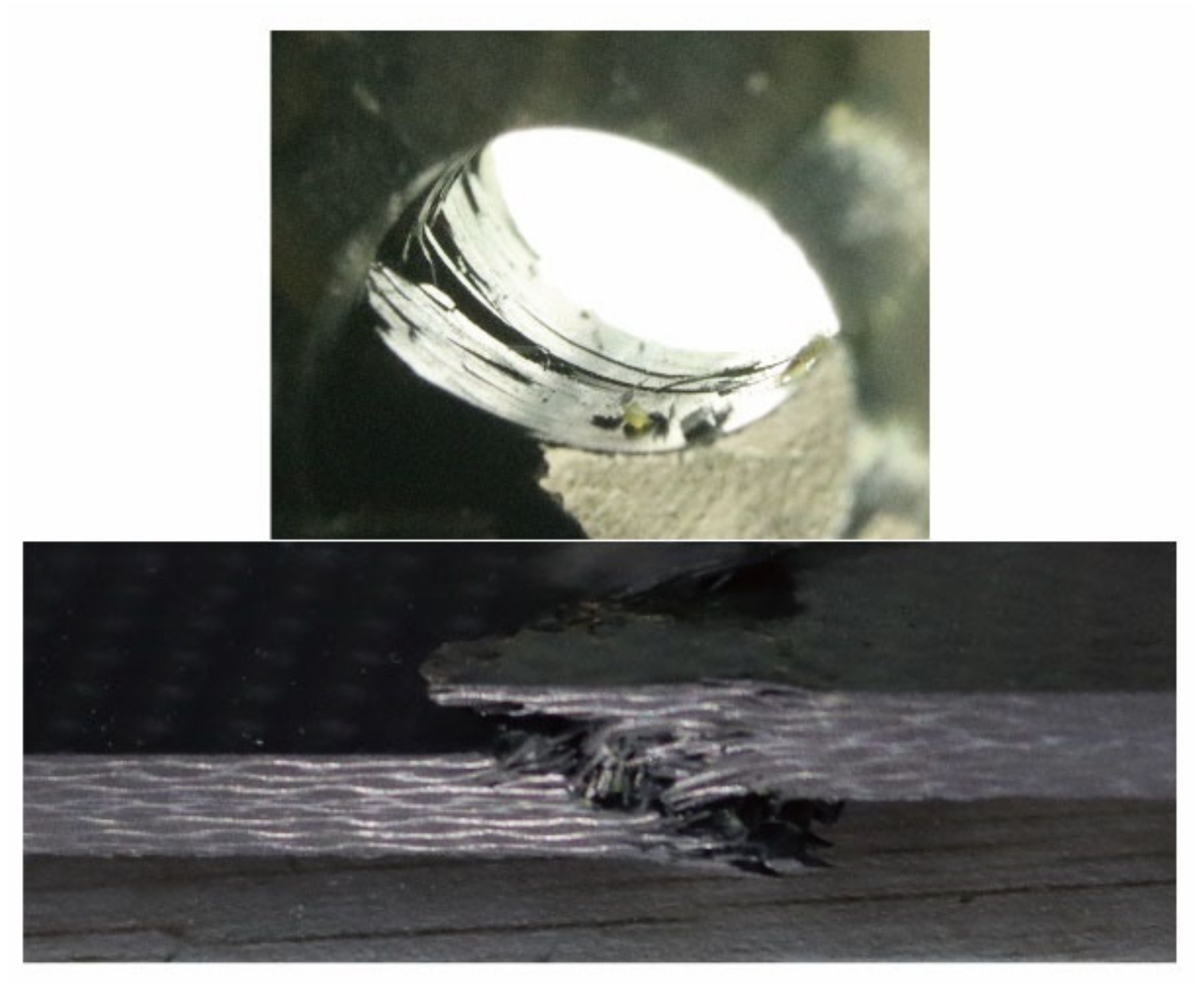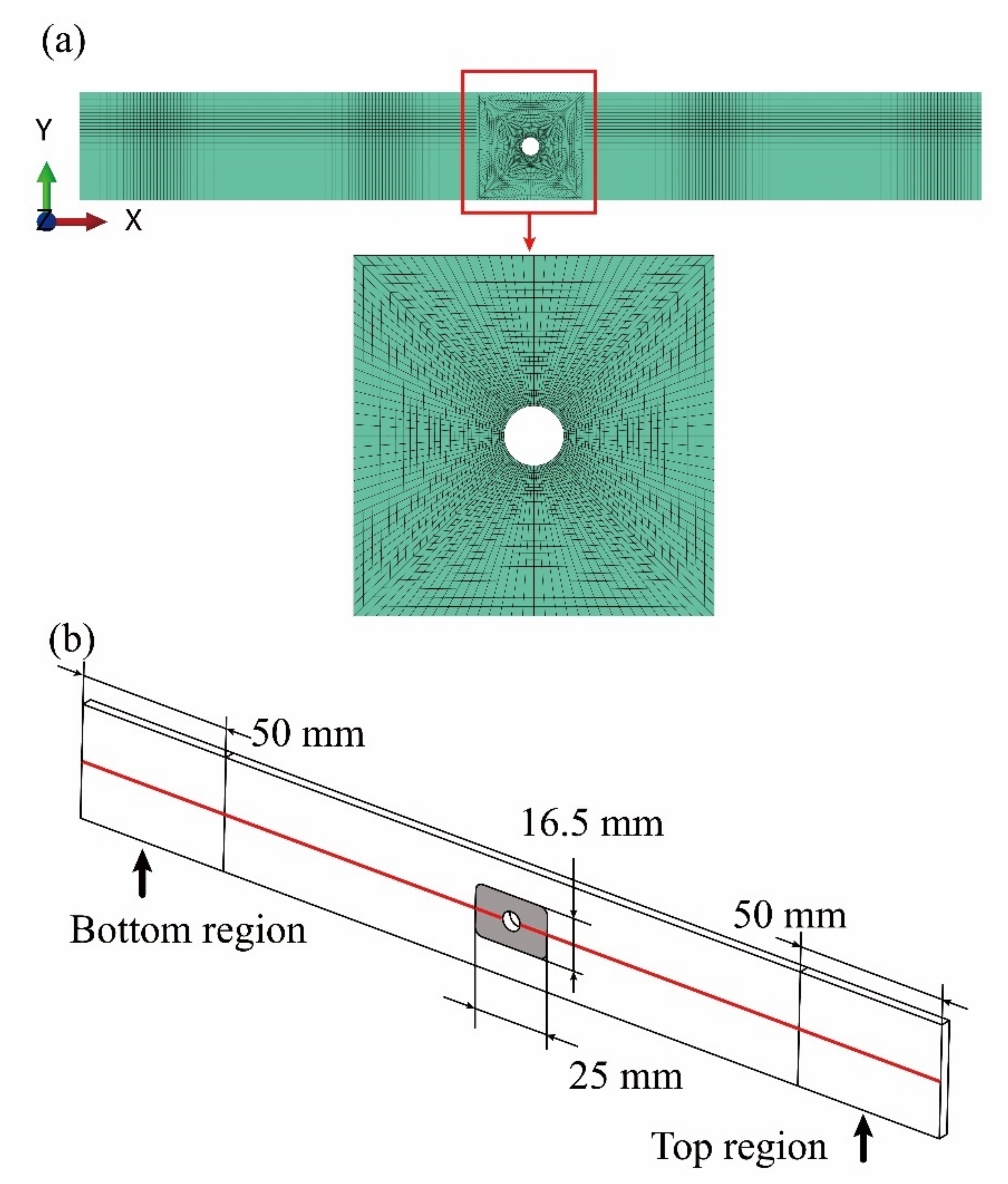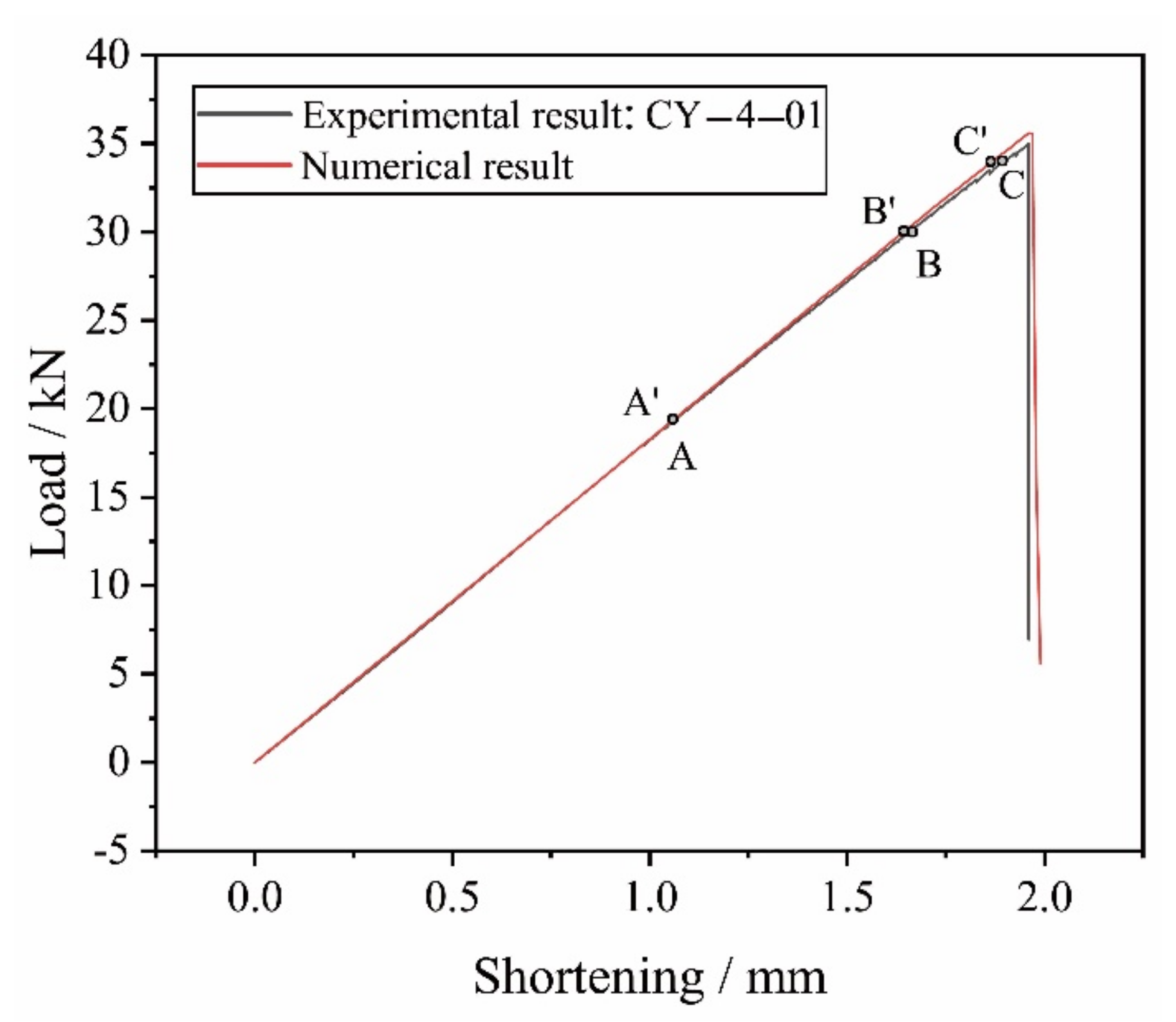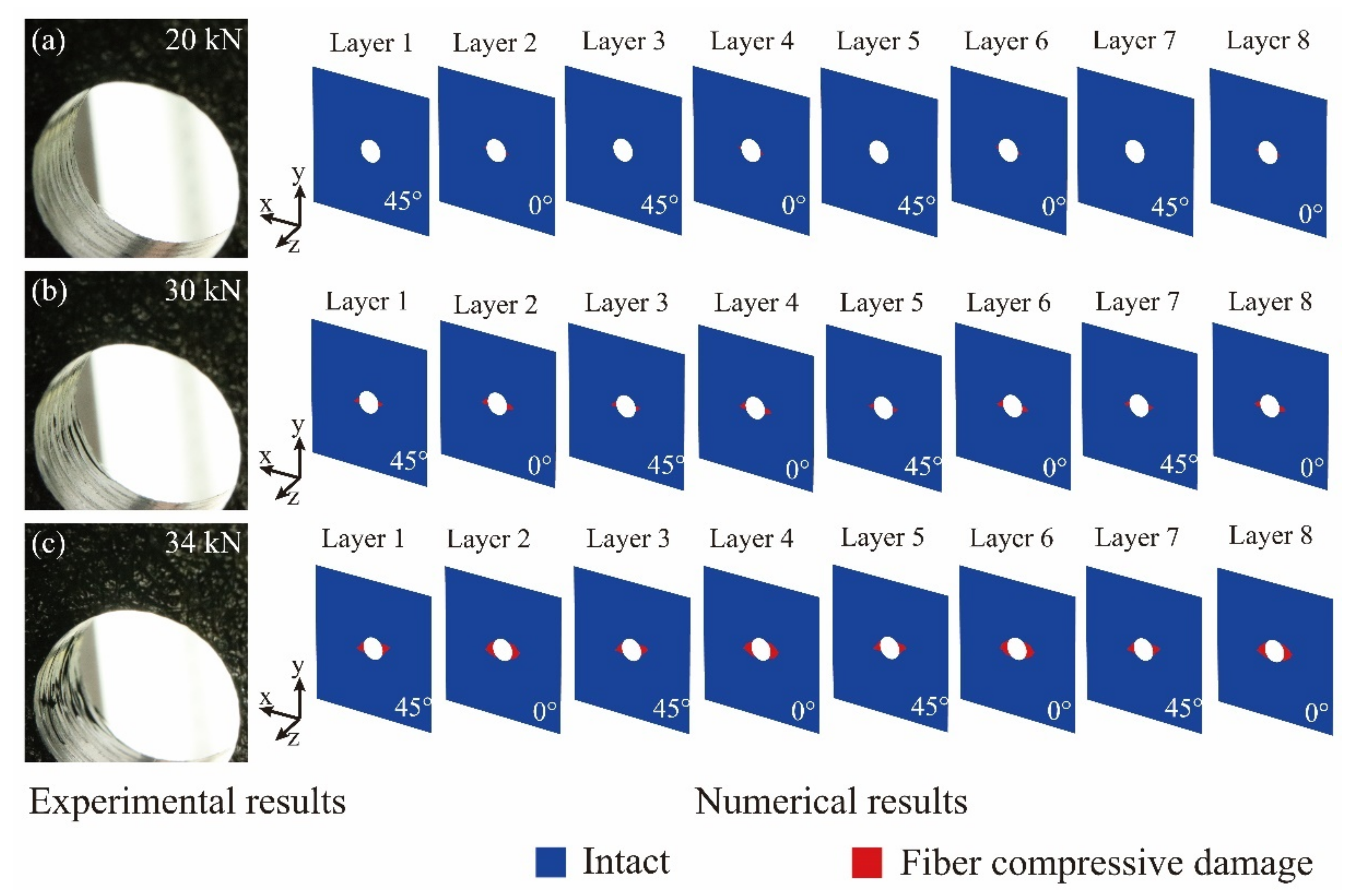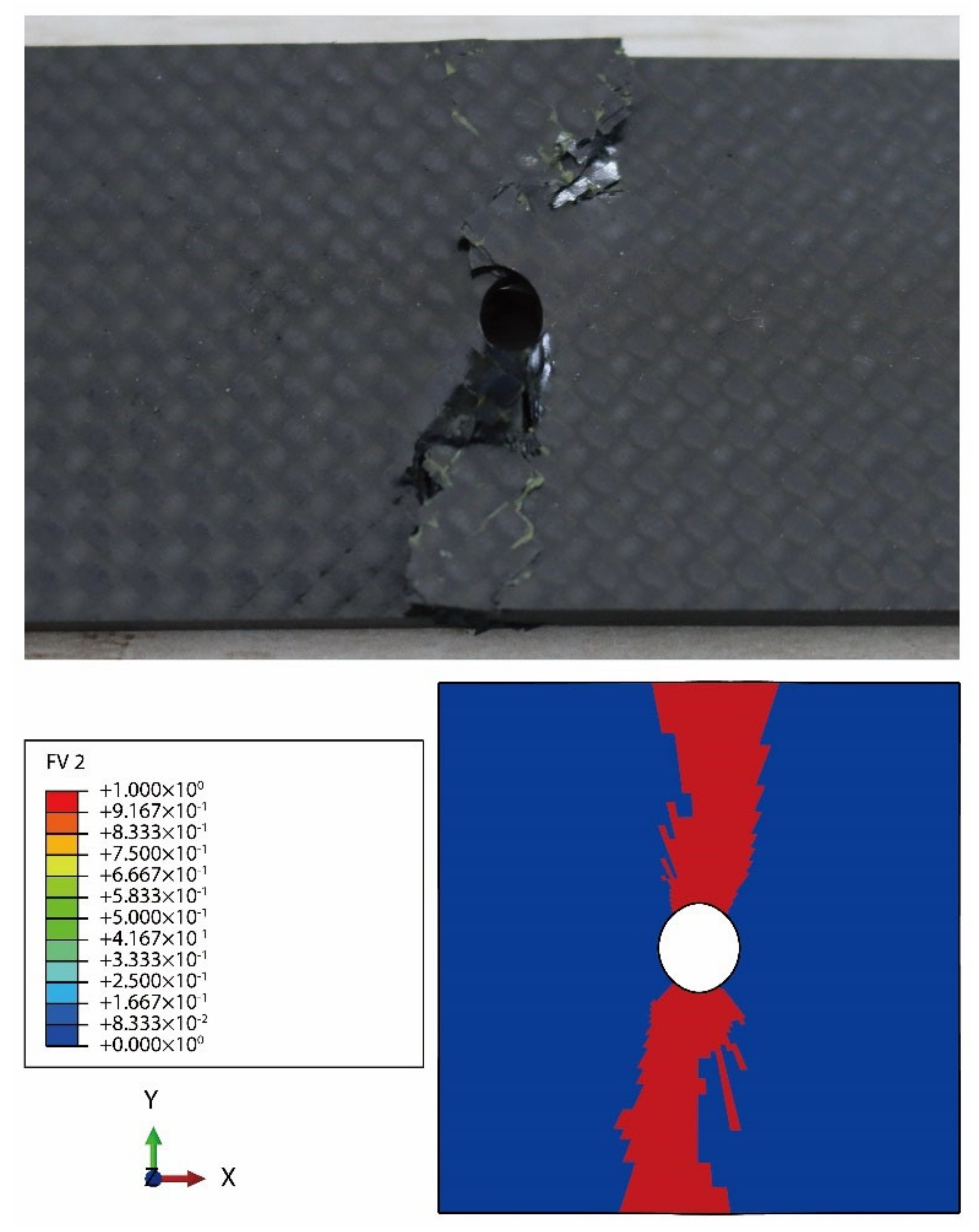1. Introduction
With high ratios of strength & stiffness to weight and outstanding corrosion resistance, fiber-reinforced composite materials are being widely used in modern air-plane structures. Plain-woven fabric composites are becoming increasingly important with the advantages of lower production costs and higher manufacturing efficiency. However, factors such as the architecture of fiber tows and the material properties of fiber and matrix constituents have considerable effects on the failure behavior and damage process of plain-woven fabric composite structures, making their damage analysis more complicated.
In order to understand the damage mechanisms and improve the design level, researches have been widely carried out on the damage process and failure behaviors of plain-woven fabric composite structures. An analytical model was presented by Donadon et al. [
1] in predicting the elastic behavior of plain weave fabric composites with different materials and undulations in the warp and weft directions and good correlations were achieved between predictions and experimental results. Mesh generating is a focused issue in the modeling of woven fabric composites. Doitrand et al. [
2] studied the applicability of voxel meshes in modeling the mechanical behaviors of plain-woven composites at the mesoscale. Grail et al. [
3] presented a method in generating smooth FE meshes for the RUC of textile composites. The presented method allowed for efficient generation of consistent and conformal FE meshes with deformed, compacted, and nested textile reinforcements. Goyal et al. [
4] studied the mechanical properties of 2 × 2 biaxial braided composites and the effects of parameters such as braid angle, waviness ratio, and material properties on the effective engineering properties of the 2 × 2 braids were investigated. Page et al. [
5] developed the two-dimensional plane strain FE models in simulating the plane woven fabric composites. The effects of relative layer shift and laminate thickness on the stiffness properties and matrix cracking behavior were analyzed.
With the aim to have a broader ken in the investigations, multi-scale methods have been widely used in the study of woven composites. Matveev et al. [
6] studied the effects of fiber strength variability on the mechanical properties of textile composites with multi-scale analytical methods. Obert et al. [
7] constructed the micro-meso relations in enhancing the meso-scale damage model for 2D woven composites. Zhou et al. [
8] studied the damage and failure behavior of 2D plain woven composites with a two-step multi-scale progressive damage analysis. With a formal-unified 3D Hashin-type criterion, the simulated results under on-axis uniaxial tension and compression showed good agreements with experimental results and the failure characteristics under different loading conditions were discussed. Wehrkamp-Richter et al. [
9] proposed a simulation framework in accurately predicting the mechanical response of triaxial braided composites based on meso-scale FE models. The numerical predictions validated the framework and underlined its potential for further damage modeling.
Various experimental methods have also been utilized in the study of woven composites. With the technique of X-ray Micro Tomography, Naouar et al. [
10] presented a direct method in determining meso-scale FE models. Carvalho et al. [
11] investigated the compressive behavior of orthogonal 2D woven fabric composites with experimental methods and the damage initiation and propagation were studied respectively in detail.
With the advantage in explaining the failure mechanisms at the constituent level, micromechanics-based failure criteria are becoming increasingly appealing for researchers in modeling the failure behaviors of composite structures. By combining macro-scale FE models with RUCs of meso and micro scales, the multi-scale analysis method takes advantages of both the efficiency of the macro analysis and the accuracy of the micromechanics-based failure criteria. Goose et al. [
12] proposed the Strain Invariant Failure Theory (SIFT) in predicting the onset of composites’ damage. In order to obtain the critical strain invariant values, strain enhancement factors are needed in the required linear finite element analysis [
13]. Tran et al. [
14] proposed a micromechanics-based modeling approach using the SIFT. Without the need for the strain enhancement factors, failure initiation sights could be identified directly to obtain the critical strain invariant values, making the multi-scale failure analysis procedure simpler. Mayes et al. [
15] proposed the micromechanics-based Multi-continuum Theory (MCT) which associated a numerical algorithm for extracting the stress and strain fields of the composites’ constituents during a routine FE analysis. With the comparison between the MCT-based simulation results and the experimental results, the effectiveness of the MCT based method was generally validated [
16]. Li et al. [
17] proposed a stress-based multi-scale failure criterion with failure mechanisms concluded from experimental observations. Open-hole tension specimens were tested and the results were compared with numerical predictions in validating the proposed criterion. Ha et al. [
18,
19] proposed the micromechanics of failure (MMF) criterion in predicting the constituent failure of composite structures. The failure of fiber was determined by a maximum stress criterion and the failure of the matrix was determined by a revised von Mises criterion. In their further investigation [
20] based on the MMF theory, micromechanical approaches were employed in investigating the effects of fiber arrangement on the mechanical behaviors of composite unidirectional laminates. Sun et al. [
21] studied the progressive failure of open-hole composite laminates with modified MMF criterion and non-iterative element-failure method. The comparison between the numerical and experimental results demonstrated the efficiency and validity of the method. With a high-efficient MMF-based failure analysis model, Lou et al. [
22] analyzed the fiber and matrix failure as well as interface debonding of macro composite structures under complex stress conditions. Considering the fiber-matrix interface in the micro-scale RUC, the failure analysis of this model showed high accuracy in the failure prediction. The multi-scale approaches combined with the MMF criterion have also been applied in predicting the damage initiation and propagation of woven fabric composite structures [
23,
24,
25,
26], indicating the huge potential of the MMF-based methods. In order to overcome the drawbacks of the MMF criterion in predicting matrix failure under longitudinal tension and shear strength, Sihn [
27] proposed the modified micromechanics of failure (MMF3) criterion in improving the prediction accuracy. Liu et al. [
28] proposed an MMF3-based multi-scale strategy with the thermal residual strength taken into account. FE models of composite laminates under off-axial loading were analyzed and the numerical predictions were validated by the experimental results.
Considering its advantage in prediction accuracy, the MMF3 criterion is utilized in this article in developing a multi-scale strategy used for the damage analysis of plain-woven fabric composites of T300/Cycom970. Micro-scale and meso-scale RUCs of plain-woven composites are established, and methods are developed in stress transformation. With the assistance of the RUCs and the macro-scale experimental data of strengths, the necessary strengths for multi-scale analysis are achieved and the MMF3-based multi-scale strategy for the damage analysis of plain-woven fabric composites is then developed. Specimens of open-hole composite laminates made of T300/Cycom970 plain woven fabrics are tested under compression. The corresponding multi-scale FE analysis is simultaneously implemented, and the numerical damage predictions are validated by the experimental results, indicating the effectiveness of the strategy.
3. Determination of the Strengths and Establishment of the Multi-Scale Strategy
In the multi-scale damage analysis of the plain-woven fabric composites with the MMF3 criterion, it is essential to determine the micro-scale strengths after the establishment of the stress transformation methods. The plain-woven fabric composite of T300/Cycom970 is chosen as the study object in this paper. The basic strength data have been obtained from the tests on T300/Cycom970 laminates made of unidirectional tapes and plain-woven fabrics first. With further calculations and corrections based on the experimental data and the FE models of RUCs, the micro-scale strengths suitable for the plain-woven fabric composite (T300/Cycom970) are then determined.
3.1. Micro-Scale Strengths of the Unidirectional Laminates
With the architecture characteristics of the plain-woven fabric composites, there are challenges in obtaining the micro-scale strengths directly from experimental strength data of fabric laminates. Based on the experimental macro-scale strengths of the T300/Cycom970 unidirectional laminates, the micro-scale strengths of the constituents are first achieved with the ordinary method.
The micro-scale RUC of the T300/Cycom970 unidirectional laminate is established as shown in
Figure 5a with the mechanical properties of the fiber and the matrix [
30] presented in
Table 2. The value of the tested fiber volume fraction of the unidirectional laminate
Vf is 0.58. 10,240 elements of C3D8R are utilized in the micro-scale RUC. The subscripts
f and
m of the parameters listed in
Table 2 represent the constituents of fiber and matrix respectively.
The tested macro-scale strengths of the T300/Cycom970 unidirectional laminates are listed in
Table 3 and are applied on the boundaries of the micro-scale RUC as shown in
Figure 6. Under each of the loading conditions, the corresponding micro-scale stresses at the reference points in
Figure 1 could be calculated with the stress transformation method introduced in
Section 2.1.1. With the calculated micro-scale stresses, micro-scale strengths of the T300/Cycom970 unidirectional laminates can be obtained.
3.1.1. Determination of Tf and Cf
In
Figure 6a, with the macro-scale longitudinal tensile strength of
XT applied on the micro-scale RUC, the micro-scale failure of fiber initiates corresponding to the macro-scale longitudinal tensile failure of the unidirectional laminates. Considering the MMF3 criterion, the maximum micro-scale stress of
reaches the micro-scale tensile strength of fiber
Tf in this condition:
where
i = 1, 2 … 8 denotes the reference points in the fiber region of the micro-scale RUC and
denotes the difference between the curing temperature of the T300/Cycom970 prepregs and the room temperature.
Similarly,
Cf can be obtained with the calculated micro-scale stresses of the reference points in the matrix region under the macro-scale longitudinal compressive strength of −
XC as shown in
Figure 6b:
3.1.2. Determination of Sm
In
Figure 6c, with the macro-scale shear strength of
S12 applied on the micro-scale RUC, the micro-scale failure of matrix initiates corresponding to the macro-scale shear failure of the unidirectional laminates. Under this loading condition, the micro-scale stresses of the reference point
i = 1, 2 … in the matrix region of the micro-scale RUC include the following components:
According to the MMF3 criterion, the micro-scale matrix failure initiates when the following condition is satisfied after going through all the reference points in the matrix region:
With the consideration of Equations (12) and (13), the micro-scale shear strength of matrix is then determined:
3.1.3. Determination of Tm and Cm
In
Figure 6d,e, with the macro-scale transverse tensile and compressive strengths of
YT and −
YC applied on the micro-scale RUC, the micro-scale failures of the matrix initiate corresponding to the macro-scale transverse tensile and compressive failures of the unidirectional laminates. With Equation (2), the macro-scale stresses are transferred to micro-scale stresses at the reference points:
In the above equations, the superscripts
T and
C represent the transverse tensile and compressive loading conditions corresponding to
Figure 6d,e, respectively.
Referring to Equations (5)–(7), the micro-scale stress compositions corresponding to the above transverse loading conditions are expressed as:
In satisfying the micro-scale matrix failure criterion in
Table 1, with
imported as a temporary variable,
Tm and
Cm are expressed as:
Under the transverse tensile loading condition shown in
Figure 6c, after going through all the reference points in the matrix region with
, the corresponding micro-scale tensile strength of matrix could be calculated and expressed as:
Similarly, with
under the loading condition in
Figure 6d, the corresponding micro-scale compressive strength of matrix can be calculated and expressed as:
Slightly difference should exist between the reasonable value of and the ratio of . In this paper, the tolerance of the difference is set as 0.001 to guarantee the accuracy in the determinations of and .
The procedures in determining the micro-scale strengths of the constituents with tested macro-scale strengths of the unidirectional composite laminates are illustrated in
Figure 7. With the macro-scale strengths shown in
Table 3, the micro-scale strengths of the T300/Cycom970 unidirectional laminates are determined and presented in
Table 4.
3.2. Strengths of the Plain-Woven Fabric Composites
In order to calculate the micro-scale strengths suitable for the plain-woven fabric composites with the MMF3 based method similar to
Figure 7, it is necessary to obtain the meso-scale strengths of fiber tows in the fabrics.
3.2.1. Meso-Scale Strengths of Fiber Tows Calculated under the Micro-Scale Strength Invariant Hypothesis
The tested mechanical properties of the T300/Cycom970 plain-woven composite laminates are shown in
Table 5 with the subscript
F representing the parameters of the fabrics. Under the micro-scale strength invariant hypothesis that the micro-scale strengths of the constituents do not change with the variation of the fiber volume fraction, the meso-scale strengths of fiber tows in the T300/Cycom970 fabrics are first back-calculated with the micro-scale strengths listed in
Table 4.
As the fiber volume fraction changes to
Vf = 0.78 in the fiber tows, the corresponding micro-scale RUC has been reestablished as shown in
Figure 5b, with the constituents’ mechanical properties and the quantity of the elements unchanged. The matrixes of SAFs at the different reference points i have been recalculated as
MR(i) and
AR(i). In
Figure 8, the procedures in calculating the meso-scale strengths of fiber tows with the micro-scale strengths of the constituents are presented.
Figure 8a is taken as an example in calculating the meso-scale longitudinal tensile strength of fiber tows
XT(tow). Considering Equation (9) and import the macro-scale longitudinal tensile strength of fiber tows with an initial value
XT0, the corresponding micro-scale tensile strength of the fiber is obtained:
Under the micro-scale strength invariant hypothesis,
in Equation (24) calculated with the proper
XT0 equals to the
Tf value listed in
Table 4. The absolute value of the difference between
and
Tf will finally be controlled under the limit of 0.001 with the iteration method, and the corresponding value of
XT0 is then determined as the meso-scale longitudinal tensile strength of fiber tows
XT(tow).
With similar methods illustrated in
Figure 8b–e, the calculated meso-scale strengths of fiber tows based on the micro-scale strengths in
Table 4 and the micro-scale RUC in
Figure 5b are presented in
Table 6.
3.2.2. Validation and Correction on the Meso-Scale Strengths of Fiber Tows
In validating and correcting the meso-scale strengths from
Table 6, the meso-scale RUC of T300/Cycom970 fabrics has been established and calculations based on experimental strengths have been carried out. The fiber tows in the RUC are modeled with a lenticular-shaped cross-section [
31] which sweeps along the arc-shaped undulation path [
26]. The geometric parameters utilized in establishing the meso-scale RUC are illustrated in
Figure 9.
In
Figure 9,
Wtow,
Ttow, and
rtow are controlling parameters that define the lenticular-shaped cross-section of the fiber tows. The arc-shaped undulation path of the fiber tows is controlled by the radius of
rU.
LRUC,
WRUC, and
TRUC represent the length, width, and thickness of the meso-scale RUC, respectively, with
WRUC equals to
LRUC considering the plain-woven structure of the studied fabrics. Referring to the relevant literature [
25,
26,
27], and the observation results with Micro CT, the values of the above parameters are determined in
Table 7.
The pure matrix region of the meso-scale RUC is discretized with the tetrahedral elements of C3D4 in suiting its geometric complexity and guaranteeing the calculation accuracy. In discretizing the regular region of fiber tows, the hexahedral elements of C3D8R are utilized in enhancing the calculation efficiency with a smaller amount of meshes. 25,668 elements are finally used in the meso-scale RUC as presented in
Figure 3, which led to both a computation-efficient and accuracy-guaranteed mesh size. 3840 elements are hexahedral elements of C3D8R which model the fiber tows and 21,828 elements are tetrahedral elements of C3D4 which models the pure matrix. For the region of fiber tows, the mechanical properties are calculated with the micro-scale RUC in
Figure 5b using the properties of the constituents listed in
Table 2. The values of the properties are presented in
Table 8 and assigned to the elements of fiber tows with the consideration of the local coordinates as shown in
Figure 3. For the region of the pure matrix in the meso-scale RUC, the mechanical properties are consistent with the properties of the matrix listed in
Table 2. Using the platform of Intel Core i7-9750H CPU in validating and correcting the meso-scale strengths of the fiber tows, the single run time of the meso-scale RUC model is 16 s.
Macro-scale strengths of the T300/Cycom970 fabric laminates (
Table 5) have been applied to the established meso-scale RUC in order to calculate the corresponding stress results as the meso-scale strengths of the fiber tows. The loading conditions and the corresponding numerical results are presented in
Figure 10. As the fill fiber tows of the meso-scale RUC mainly bear the transverse load under the loading conditions of
YT(F) and
YC(F), the corresponding calculated stresses in the fill fiber tows are similar to results in the warp fiber tows of the meso-scale RUC under the longitudinal load of
XT(F) and
XC(F). With the above characteristics, transverse strengths of the fiber tows (
YT(tow) and
YC(tow)) cannot be validated with the calculation method based on the meso-scale RUC and the macro-scale strengths of fabric laminates.
The calculated meso-scale strengths with the above method are listed in
Table 9 and compared with the results based on the micro-scale strength invariant hypothesis. The meso-scale strength of
XC(tow) obtained from the micro-scale strength invariant hypothesis is smaller. Typical failure modes of composite unidirectional laminates [
32] and fabric laminates [
11] under axial compression are presented in
Figure 11. As the fiber micro-buckling caused kink band stands the leading role in the compressive failures of the composites, the lateral support provided by the fill tows will enhance the longitudinal compressive strength of the fiber tows by postponing the initiation of the fiber micro-buckling and the subsequent kink band. The effect of lateral support provided by the fill tows is not considered in the micro-scale strength invariant hypothesis, leading to the smaller prediction of the longitudinal compressive strength of fiber tows
XC(tow). The other two meso-scale strength parameters are validated since the meso-scale strengths of
XT(tow) and
S12(tow) obtained from the two methods are close to each other.
The corrected meso-scale strengths of the fiber tows in the studied T300/Cycom970 fabrics are listed in
Table 10, along with the corresponding micro-scale strengths of the constituents suitable for the T300/Cycom970.
3.3. The Multi-Scale Strategy for the Failure Analysis of the Plain-Woven Fabrics
With the above methods of stress transformation and the essential micro-scale strengths of the constituents, the multiscale strategy for the failure analysis of the plain-woven fabric composites has been developed as illustrated in
Figure 12.
At the beginning of each load increment, the stresses of the elements in the macro-scale FE models are calculated first and then transferred into the meso-scale stresses at the reference points of the meso-scale RUC with the method illustrated in
Section 2.1.2. For the region of the pure matrix in the meso-scale RUC, since the meso-scale stresses are equal to the micro stresses, they are imported directly into the MMF3 criterion in determining the micro-scale failure of the matrix. For the region of the fiber tows in the meso-scale RUC, the meso-scale stresses are further transferred into micro-scale stresses at the constituents’ reference points with the method illustrated in
Section 2.1.1 based on the micro-scale RUC shown in
Figure 5b. The micro-scale stresses are then imported into the MMF3 criterion in determining the micro-scale failure of the constituents in the region of the fiber tows.
Once the micro-scale stresses satisfy the MMF3 criterion in
Table 1, the damage initiates, and the properties of the corresponding constituent are degraded in implementing the progressive damage. The degradation methods [
28] utilized in this paper are presented in
Table 11.
As the properties of the constituents degrade, the mechanical properties of the matrix and the fiber tows in the meso-scale RUC degrade correspondingly, along with the degradation of the macro-scale mechanical properties of the plain-woven fabric composites. In the following load increment, the recalculated SAFs based on the degraded RUC models are utilized in the transformation of the stresses and the MMF3 criterion is further utilized in the determination of damage evolution. The above procedures cycle until a sharp decrease of load occurs, which indicates the collapse of the specimen.
Compression experiments have been performed on the open-hole composite laminates made of T300/Cycom970 plain-woven fabrics. The experimental results are compared with the numerical results of the multi-scale finite element analysis in order to validate the above proposed methodology.
